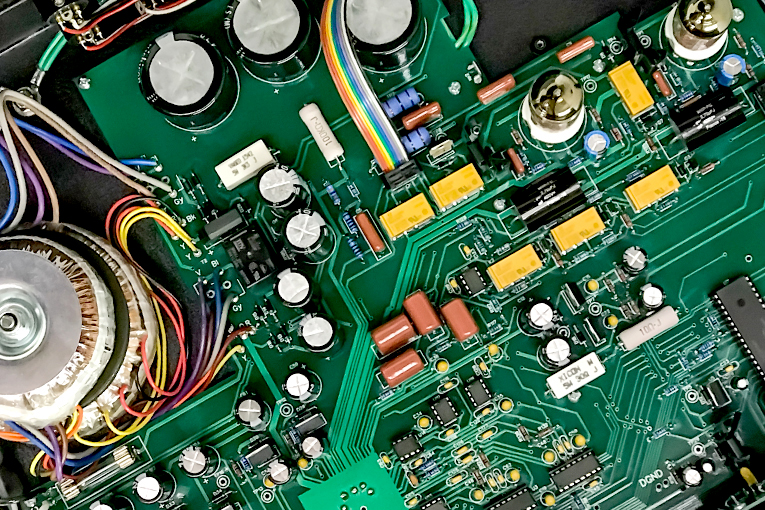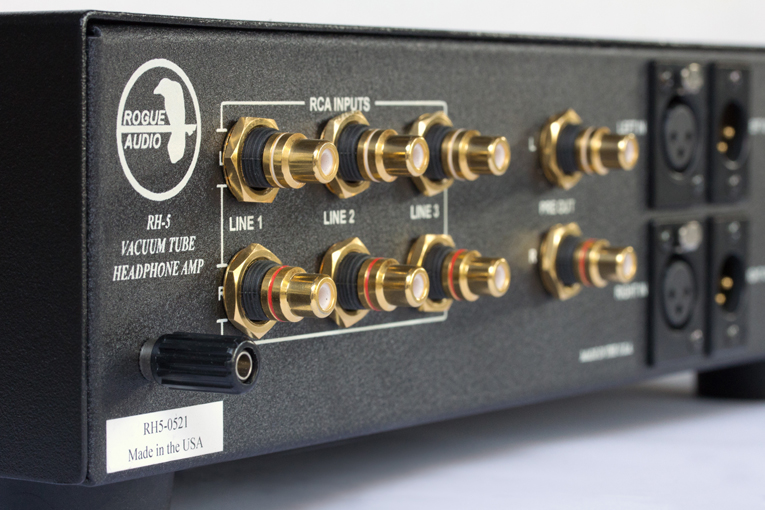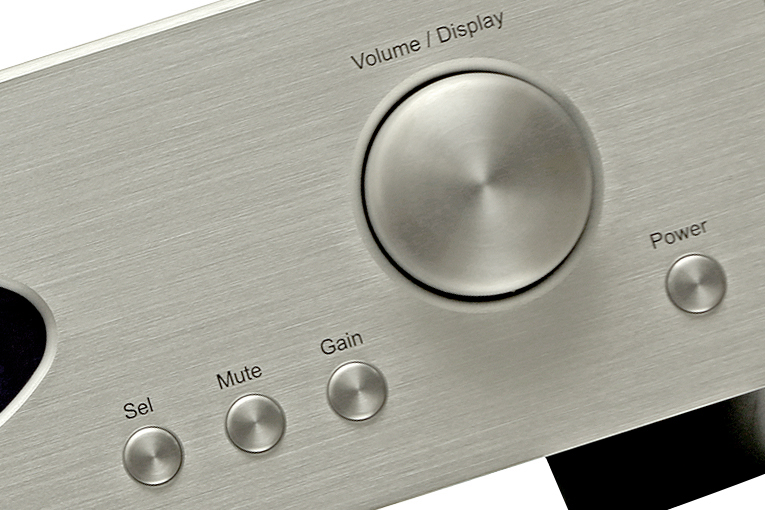Sound: 









Value: 









(Read about our ratings)
Measurements can be found by clicking this link.
Pennsylvania-based Rogue Audio has been producing tubed electronics for 20 years. Although they’ve long included headphone jacks on many of their products, Rogue is not oblivious to the demands of today’s ever-growing market of headphone enthusiasts. Many high-quality headphones can sound great when plugged directly into a smartphone, but their sound can often further benefit from connection to a dedicated headphone amplifier fed signals from high-quality source components. Some high-end headphones require greater power than a smartphone, or even the headphone amp in a typical audio component, can deliver. Rogue’s solution to these needs of the headphone aficionado is the RH-5 headphone amplifier-preamplifier ($2495 USD).

Description
The RH-5 measures 15”W x 4”H x 13.5”D and weighs a reassuringly robust 19 pounds. In Rogue’s usual unostentatious fashion, the case is stamped steel finished in matte black, and the front panel is a slab of machined aluminum in black or silver. At the center of the front panel, an oval OLED screen displays the volume level, selected source, and gain setting. To the right of the display are buttons for input selection, mute, and gain. Farther right is the Volume/Display knob, which adjusts the volume in increments of 0.5dB, and below that a Power/Standby button. These controls are duplicated on the included remote handset, along with a button for turning off the display.
To the left of the display are the headphone outputs: two combination three-pin XLR and 1/4” TRS jacks, for connecting a pair of balanced headphones or simultaneously driving two pairs of unbalanced headphones; and a four-pin XLR jack for balanced headphones requiring that termination. On the rear panel are a ground post for use with the optional moving-magnet/moving-coil phono board; three pairs of unbalanced inputs (RCA) labeled Line 1, 2, and 3; one pair of unbalanced preamp outputs (RCA); one pair each of balanced inputs and preamp outputs (all XLR); and, finally, an IEC mains inlet and rocker power switch.

The RH-5 uses two 12AU7 tubes to provide the voltage gain, and a MOSFET buffer to help the circuit deliver high current into low-impedance headphones. With three levels of gain available -- 3, 12, and 16dB -- a power rating of 3.5Wpc into 32 ohms, and a specified output impedance of less than 0.1 ohm, the RH-5 should be able to accommodate everything from sensitive in-ear monitors to the most hard-to-drive planar-magnetic headphones.
In the box
The RH-5 is shipped in a sturdy cardboard carton, within which it’s wrapped in plastic and suspended with Styrofoam inserts. Also included are a power cord, the remote control and its batteries, and an owner’s manual.
In use
Because the RH-5 is shipped with its tubes already installed, all that was required to get it up and running was to connect the power cord and ancillary equipment. As a source, I mostly used my Ayre Acoustics C-5xeMP universal disc player via a pair of DH Labs Revelation balanced interconnects. While I focused my listening on the RH-5’s performance as a headphone amplifier, I also used it as a stereo preamplifier, with its single-ended outputs driving Rogue’s Atlas Magnum II power amplifier (review forthcoming). In an attempt to get a broad perspective on the RH-5’s sound, I used it with a variety of headphones: Audeze LCD-X and Quad ERA-1 planar-magnetic headphones, Massdrop x Sennheiser HD 6XX high-impedance dynamic headphones, and Etymotic Research ER-4PT earphones. I ran the Audeze and Quad ’phones both balanced and unbalanced.

Despite the RH-5’s use of tubes, I found it had relatively little self-noise, and was actually quieter than some of the fully solid-state headphone amps I’ve reviewed. In its lowest gain setting, with the volume level at maximum, I could hear some faint hiss. Tube hiss was clearly audible at maximum gain and maximum volume -- but with any of the headphones I used, that combination of gain and volume would have been courting hearing damage. I found that the Rogue could drive any of my headphones to more than adequate levels at its lowest gain setting, so that’s what I used for most of my listening. At normal levels there was no hiss, but with some headphones I noted some just-audible high-frequency noise in a quiet room. This noise didn’t vary with volume level or gain setting, but was louder in balanced than in unbalanced operation. Turning off the display eliminated most of the noise, but I could still vaguely tell the amp was on.
Sound
Headphone amplifiers differ much less in sound quality than do headphones themselves. Still, when one is paying attention, as one is likely to do when spending $2495 on a headphone amp such as the Rogue RH-5, differences emerge. The sonic signature of the RH-5 was to the warm side of neutral, with very slightly rounded edges, full bass, and big aural images.
In Ella Fitzgerald and Louis Armstrong’s Ella and Louis (CD, Verve 825 373-2), the RH-5’s lush midrange gave Fitzgerald’s voice a golden glow. Armstrong’s voice was a touch smoother than I’m used to hearing it, but still had plenty of gravelly texture, and his trumpet was bright and clear without ever sounding tinny. Keeping with classic jazz, the RH-5 lent a pleasing breadth and depth to the sound of Eddie Gomez’s double bass in the Bill Evans Trio’s California Here I Come (CD, Verve VE 2-2545), without unduly interfering with the timing of those notes.
Vadim Gluzman’s violin, in his recording of Bruch’s Violin Concerto No.1 with the Bergen Philharmonic Orchestra under Andrew Litton (SACD/CD, BIS 1852), had plenty of rich body and never sounded steely, as violins can through some equipment. The RH-5 also gave a burnished quality to the brass in Michael Tilson Thomas and the San Francisco Symphony’s collection of Mahler orchestral songs (SACD/CD, San Francisco Symphony 821936-0036-2), and in passages for full orchestra there was great density and a concomitant sense of grandeur.

When I want to hear density from something other than orchestral music, I often turn to “Layla,” from Derek & the Dominos’ Layla and Other Assorted Love Songs (SACD/CD, Polydor B0003640-36). Through the RH-5 I heard the big wall of sound I was looking for, while still being able, if I chose, to discern the numerous layers used to build up that wall. “Layla” also demonstrated that the RH-5’s dense sound and rich tones weren’t at the expense of energy and drive -- both were there in abundance.
With a good recording and a good pair of headphones, most headphone amps can do a competent job of generating coherent aural images. Through the RH-5, I found those images bigger and denser than usual. Bill Evans’s California Here I Come is a fairly intimate recording, but through the RH-5 the players were set back far enough from my ears to let some space breathe around them, while maintaining a solid core to the sound of each instrument. The applause at the end of each number was slightly farther back, giving an impression of the recording venue. The relative closeness of the applause was just right -- the Village Vanguard is a small club.
The sense of space was more profound in Marek Janowski and the Berlin Radio Symphony Orchestra’s recording of Wagner’s Der fliegende Holländer (SACD/CD, PentaTone PTC 5186 400). This opera involves the chorus more than do most Wagner operas, and it was particularly in those passages that I appreciated the Rogue’s ability not only to fill a continuous soundstage from beyond my left ear to beyond my right, but to convey enough depth that I could imagine myself in a large hall with the singers in front of me, rather than the music going on inside my head. Soundstaging was one area in which I felt balanced operation delivered a noticeable though undramatic improvement over the same headphones run unbalanced -- particularly in further expanding the left-right spread.

Using the RH-5 as a preamplifier with Rogue’s Atlas Magnum II power amp, I found the RH-5 to have the same fundamental tonal characteristics as when I used it, alone, with headphones. Of course, soundstaging is a different experience through loudspeakers, and here I found the RH-5 good but not exceptional. Images extended just outside my speakers, and began somewhat behind the speaker plane, with moderate variation in depth. In the Wagner recording, the chorus was set back a few feet behind the speakers, but I heard a bit more image specificity from the Atlas Magnum II when driving it with a Grace Design m902 headphone amp as a preamplifier.
Comparison
For comparison, I used my longtime reference headphone amplifier-preamplifier-DAC, Grace Design’s m902 ($1695, no longer available). I still used the Ayre C-5xeMP as a source, both to put the amplifiers on an even footing and because the Ayre sounds better than the DAC built into the Grace m902. Thanks to both amps having digitally controlled volume controls adjustable in 0.5dB steps, once I’d measured the offset with a test tone, it was easy to ensure that my comparisons were always conducted at the same volume levels for both amps.
Many recording professionals consider the Grace’s sound to be neutral, but against the RH-5 it sounded slightly bright. For example, Bill Evans’s piano was a bit more tinkly, and with the Bruch concerto the m902 put more emphasis on the solo violin’s strings, while the RH-5 emphasized the instrument’s body more. The RH-5 was fuller in the bass, but the m902 had better definition. With the New York Philharmonic’s recording of Shubert’s Symphony No.8 (24/96 burned to DVD-A, NYPO), there was more energy in the pizzicato bass notes in the second movement through the RH-5, but those notes had more shape through the m902.

Similarly, with “Lose Yourself to Dance,” from Daft Punk’s Random Access Memories (24/96 burned to DVD-A, Columbia Édition Studio Masters), the kick drum had plenty of volume through the Rogue, but I heard sharper attacks and more of the character of that particular kick drum through the Grace -- though neither headphone amp is the final word in bass slam. The Grace also brought out more fine detail -- for example, the scrape of Gluzman’s bow across his violin’s strings in the Bruch -- though some of that perception may be due to its brighter tonal balance. The two amps’ portrayals of space also differed: the Grace was more open, while the Rogue’s images were more filled in.
Conclusion
Rogue Audio’s RH-5 is a great choice for the headphone aficionado who also cares about freestanding speaker listening. It has enough inputs and outputs -- including that optional phono board -- to serve as the centerpiece of most systems. Its selectable gain, high current capability, and balanced output should be able to drive most any headphone model. And while no sonic profile will please everyone, the RH-5’s full bass, warm midrange, and expansive images are sure to find many fans. If you hear it, you may well be one of them.
. . . S. Andrea Sundaram
Associated Equipment
- Headphones -- Audeze LCD-X, Etymotic Research ER-4PT, Massdrop x Sennheiser HD 6XX, Quad ERA-1
- Headphone amplifier -- Grace Design m902
- Source -- Ayre Acoustics C-5xeMP
- Power amplifier -- Rogue Audio Atlas Magnum II
- Speakers -- Esoteric MG-10
- Subwoofer -- REL R-328
- Interconnects -- DH Labs Revelation, QED Silver Spiral
- Speaker cables -- AudioQuest GBC
- Power conditioner -- Equi=Tech Son of Q
Rogue Audio RH-5 Headphone Amplifier-Preamplifier
Price: $2495 USD.
Warranty: Three years parts and labor; six months, tubes.
Rogue Audio, Inc.
PO Box 1076
Brodheadsville, PA 18322
Phone: (570) 992-9901
Email:
Website: www.rogueaudio.com




